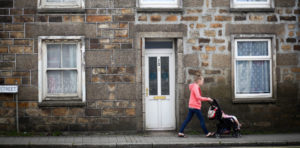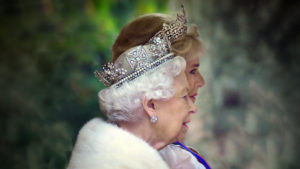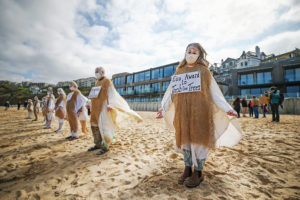Nansledan is a partially built village on a hill at Newquay: the wind blows through, almost knocking me off my feet. The Cornish housing crisis is a paradigm of the national one: towns filled with holiday lets and Airbnbs while locals live in caravans or appallingly maintained rental accommodation because prices are so high. Here is a potential solution from the King, of all folk: he dreamt it when he was still Duke of Cornwall, a title now passed to the Prince of Wales. Nansledan (“broad valley” in Cornish) is built on duchy land to duchy specifications by duchy-approved builders. It is the sequel to Poundbury, the King’s ideal town in Dorset, which appears as you drive on the A35 towards Dorchester, with the same, doubtless unconscious, impact of a medieval fortress on an escarpment.
So feudalism returns to save us from ourselves and, like feudalism, Nansledan has a wild charisma. There is a granite obelisk at the roundabout, by the kind of Art Deco building you might see on the finer parts of the North Circular. It is made of Bodmin granite, and it marks the King’s first visit to Nansledan in 2014. I spend three days here — I was trapped after one of Cornwall’s rare snow flurries — and I think I know a lot about the king from the village that walked out of his head. There is something sensitive and thwarted about him — his watercolours are idealistic, and fragile — and Nansledan mirrors this. There are bird nooks in the walls of cottages, a herd of cows browsing in a wildflower meadow, and solar panels on roofs designed to look like slate. The school looks like the Overlook Hotel in The Shining — it has stolen its roofline — but that is a rare mistake, and surely not his. Everyone remarks on his taste.
There is a master plan. It shows sector after sector rising over 25 years, courtesy of approved builders: Morrish Homes; Wainhomes; C G Fry and Son. Eventually it will have 4,000 homes, produce one job in Nansledan for every household, and will meet up with Newquay Orchard, another expression of the king’s preoccupations, across the valley. (A stone at the base of a tree in the orchard says, rather ruefully: “We are all growing.”) It has principles which summon a village of the past, but with pain scrubbed out. There is no typhoid or indentured servitude here, though people are appreciative of the king, and talk about him fondly: “You know he’s coming when people start sweeping things up, and finishing houses.” I pity the republicans here, who statistically must exist, but people will do a lot for good housing nowadays.
Everything is within walking distance to discourage cars. Small independent businesses are favoured, though a Little Waitrose made it into Queen Mother Square in Poundbury, possibly because it stocks Waitrose Duchy Organic. Apprenticeships of traditional crafts are promoted, as is renewable energy. Freeholders must sign a covenant agreeing to maintain their buildings according to duchy principles, and holiday lettings and the placing of whole buildings on Airbnb are banned. Of the housing, 30% is reserved for social housing, affordable housing, and shared ownership — a high proportion for Cornwall and for England — and it took a royal duchy to do it.
I have only lived in old houses and older towns, and nothing prepares me for the oddness of Nansledan. I’ve never seen a village like it: there are no road markings, no mature trees, no church, no pub and, for a village, very few people. Mothers with buggies flee past, out of the wind; young children scoot on pristine streets. There is a glut of parking, which is astonishing for Cornwall: Elysium.
Art Deco is where the king’s clock stops. Otherwise, Nansledan winds its way from medieval through Queen Anne to neat Victorian cottages. They are painted in pastels, like that street in Notting Hill: pale pink, pale blue, pale green. Nansledan: meet Instagram. The impression is of a box of macaroons stranded on a hill, stamped with a crown: a Duchy Original village, and it is both addictive and curiously oppressive, due to the intensity of its vision. I have a fantasy that he lives here in an ice-blue Victorian pastiche cottage, sticking his nose out of his door, and sniffing his cherry trees. I think he should: it is his.
The house builders have their offices on the main road by the obelisk. Donna from Wainhomes takes me to the show home, a white oversized cottage on three storeys, with a cherry red front door. If the exterior aesthetic is disorientating, the interior is generic: it’s a show home clad in neutrals, well-designed and finely built. Perhaps it is a metaphor for monarchy itself: something ancient rebuilt with mod cons to stay pleasing, a common royal contortion in the shape of a house.
“It’s like a fishing village,” says Donna and it is, if you have never seen a fishing village. There are no fish, and no sea, and no Lidl, and no foodbank. Cornwall tends to divide itself into local and tourist aesthetic, and Nansledan has chosen the tourist aesthetic. This is not wrong — why should it be? — but it is new, and therefore odd.
In a parade of shops, I find life at the Methodist community space. I peer in, see two women and two dogs, and they wave me inside. I sense that Nansledan, which is isolated on its hill, is very like St Mary’s on the Isles of Scilly: in a few minutes everyone will know who I am, and why I am here. Clare Anderson is the Methodist minister in Newquay. She lives here because the Methodists were going to build a church at Nansledan, but costs spiralled, and they will build in Newquay instead: there will be no idealised church. She has lived here for four years.
“There’s a lovely sense of community apart from the keyboard warriors and the people who are a bit cliquey,” she says, when I ask what it is like living in a partially built ideal village. “Because the duchy has got a design code it’s almost a stick to beat people with.” No one will tell me explicitly about WhatsApp fights relating to hanging baskets — it’s too new and small a community to criticise the neighbours openly — but they don’t have to. I can sense them. They have sworn fealty to their village and its design code, and woe betide those who won’t conform.
“It’s a mixed environment,” Claire says, “but nonetheless it feels like a wealthy development and that brings its own prejudices and baggage. There are coffee shops where a cup of coffee is expensive. If you were living in affordable housing here it would be completely unobtainable.” She is a town councillor, and she knows the misery of the housing crisis — she says every local Facebook group is filled with pleas for housing as rentals are sold for Airbnbs. I ask her what Nansledan will achieve. “30% of these houses is just a drop in the ocean,” she says, looking about. “It’s not something Nansledan can solve.” At least, not alone, and so Nansledan functions partially as a rebuke, and partly as — and this is universal — something that others cannot have.
I visit Newquay. There is nowhere to buy food in Nansledan when the cafes and the chocolate shop and the bakery close at dusk. Newquay is the same as most mid-sized Cornish towns, grand — the waves are vast, rolling in off the Atlantic — and rotting. It has none of the finesse of Nansledan, but it feels real nonetheless, and therefore comforting. I find a pasty in Warren’s, and the prototype for Nansledan: a small estate called Tregunnel Hill near the boating lake. Within Newquay, the duchy aesthetic feels less deranged than in Nansledan: that is, it looks like a piece of high Victorian Eastbourne, transplanted to Cornwall by people with time and leisure for good taste.
On the way back I stop in St Columb Minor, the closest village to Nansledan. Sometimes in winter Cornwall feels like a shoulder closed to the wind. A woman with a vast fur hood tells me she thought Nansledan was like Noddy’s Toytown when it emerged from the farmland. (There is a still a farmhouse. It is proudly unrenovated. It looks angry, for a house). She regards Nansledan in the same way that she might regard Asgard. “A hundred pounds for a cardigan,” she says, amazed, and says that Nansledan is not for her: too expensive. It is true that it is expensive for Newquay — an open-market three-bedroom house is £330,000 in Nansledan against £250,000 outside it — but as of last August 45% buyers of open-market homes were from Newquay, and 70% were from Cornwall. (This is down from 72% in May 2020.) There are a few second homeowners, but they keep their heads down, like women living among religious fundamentalists.
I visit the shops, which are offered at good rates to suitable businesses, which must go through a detailed application process. There are rules on signage colour, placing and font. Eventually there will be a vast marketplace but for now Nansledan sells pretty food and, above all, aesthetics, as if they sing to each other. There is a café called Shiva with an attached yoga studio, two homeware shops — one also sells clothes — a giftshop with a minimalist bucket and spade, two hairdressers and a boutique which I suspect is the source of the £100 cardigan slur. Nansledan is already a shopping destination. Local people come to the Ladyvale bakery to eat gluten-free cakes, admire the papery flowers on the ceiling and, above all, park their cars.
In Shiva I meet a young woman who used to lived here with her father over his blinds and awning shop: she has a baby, and she is as lovely as anything in Nansledan. She has now bought a home here with her partner for 60% of market value under a section 106, which will remain affordable even if she sells it on: her previous home in Newquay has Airbnbs on both sides. “There were so many people who applied for our house,” she says. “They chose us!” She adores Nansledan: “It’s like a movie set, it’s so perfect”. The Cornish relationship to affluence is complicated. It must be, in a relatively isolated and culturally feudal duchy with a thriving entrepreneur class on the one hand, and some of the poorest people — and housing — in western Europe on the other.
But Nansledan admits no such tension openly: it is as smooth as icing sugar. This is the village of a perfectionist, who has lined up every Cornish element he can find. The street names are Cornish. The granite and slate are Cornish. The houses are Cornish-shaped; there is even a tiny replica of the ducal manor house at Restormel. The effect of all this Cornishness, of course, is to make Nansledan seem very un-Cornish. It is pastiche, and that is forgivable. If it isn’t Cornish, then neither is he, but he gifts his vision – his experience – of Cornwall to them, and they accept it happily.
I think the contradiction — the potential offence — of Nansledan is that something so fine has emerged from a feudal remnant and is likely to be fetishized for it; perhaps we will want more of it, since government and council cannot provide. It offends our far newer belief in democracy, which has not provided the housing people need: on the contrary, children are dying in mouldy homes due to the greed of landlords enabled by our insane planning laws. It takes a man who can afford not to be greedy, to show us the error of greed in house building, and I can’t think of anything more depressing, or more English.
Nansledan is not just an aesthetic marvel I am confused by, because it meddles with time and space. Above all, it is a failure of government, and so we look backwards for a solution, and establish an idealised village in less than a decade. I can laugh at the fishing village without fish or fishermen and the Waitrose magazine aesthetic fallen on the streets like snow, but the truth is I don’t have a friend in Cornwall who wouldn’t want an affordable home in Nansledan, and that is both cheering and pitiable.
Disclaimer
Some of the posts we share are controversial and we do not necessarily agree with them in the whole extend. Sometimes we agree with the content or part of it but we do not agree with the narration or language. Nevertheless we find them somehow interesting, valuable and/or informative or we share them, because we strongly believe in freedom of speech, free press and journalism. We strongly encourage you to have a critical approach to all the content, do your own research and analysis to build your own opinion.
We would be glad to have your feedback.
Source: UnHerd Read the original article here: https://unherd.com/




